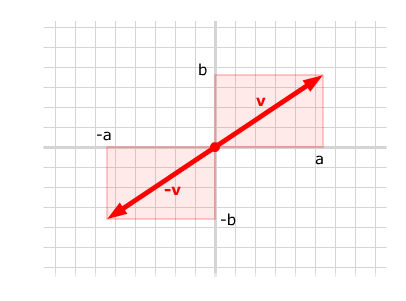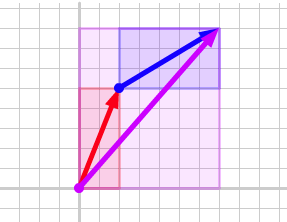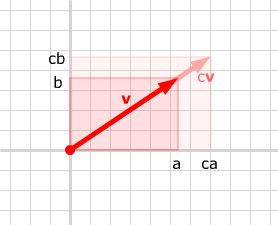- 0 = [0, 0]
- –v = [ –v1, –v2]
- u + v = [u1 + v1, u2 + v2]
- u – v = [u1 – v1, u2 – v2]
- cu = [cu1, cu2]
- 0 = 0i + 0j
- –v = –v1i – v2j
- u + v = (u1 + v1)i + (u2 + v2)j
- u – v = (u1 – v1)i + (u2 – v2)j
- cu = cu1i + cu2j
The easiest vector to calculate is the zero vector - when its tail is at (0, 0), its head is as well, so its components are both 0:
0 = [0, 0] or 0 = 0i + 0j.
The next easiest to figure out is the negative of a vector - a little bit of triangle geometry shows that
if v = [a, b], then –v = [–a, -b]
or equivalently
if v = ai + bj, then –v = –ai – bj.


This means that, to find the components of the sum, we just add the components of the individual vectors:
if u = [a, b] and v = [c, d], then u + v = [a + c, b + d] .
This is true for any pair of vectors in 2-space. In the diagram below, change the red and blue vector by dragging their heads and look at the widths and heights of their containing boxes. What happens if one or more of the components of the vector is negative?
u = ai + bj, v = ci + dj.
Then
u + v = (ai + bj) + (ci + dj) .
Since vector addition is both commutative and associative, you can rearrange the sum in any order:
u + v = (ai + ci) + (bj + dj).
Then, using the first distributive rule, you get what you want:
u + v = (a + c)i + (b + d)j .
u - v = u + (-v) = (ai + bj) + (-ci - dj) = (a - c)i + (b - d)j
i.e. to find the components of the difference of two vectors, just subtract their individual components.

In symbols, if v = [a, b], then cv = [ca, cb].
You can also use algebra to derive this rule. If v = ai + vj, then
| cv | = c(ai + bj) = c(ai) + c(bj) = (ca)i + (cb)j |
(using the second distributive rule) (using the rule that the order of scalar multiplications doesn't matter) |
- 0 = [0, 0, 0]
- –v = [–v1, –v2, –v3]
- u + v = [u1 + v1, u2 + v2, u3 + v3]
- u – v = [u1 – v1, u2 – v2, u3 – v3]
- cu = [cu1, cu2, cu3]
- 0 = 0i + 0j + 0k
- –v = –v1i – v2j – v3k
- u + v = (u1 + v1)i + (u2 + v2)j + (u3 + v3)k
- u – v = (u1 – v1)i + (u2 – v2)j + (u3 – v3)k
- cu = cu1i + cu2j + cu3k
Suppose u, v and w are vectors in 3-space and c is any scalar. In terms of components with respect to some coordinate system in 3-space,
 Vectors
in Coordinate Systems Vectors
in Coordinate Systems |
||||
| Introduction | Two-dimensional coordinate systems | Three-dimensional coordinate systems | Using components to calculate with vectors | Calculating the length of a vector |